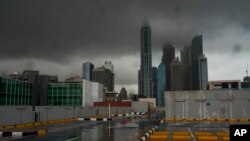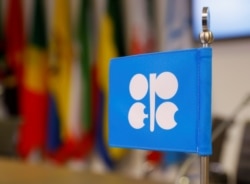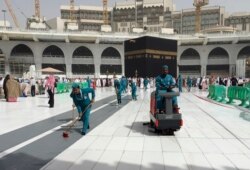The shock to the global economy from the coronavirus outbreak is hitting Middle East economies particularly hard, analysts say.
“It’s a double whammy shock for the region,” said Jihad Azour, who directs the International Monetary Fund’s Middle East and Central Asia department.
“First was the shock of the eruption of the virus from China because the region is strongly connected to China in terms of trade and services. The second episode came with the decline of demand in oil,” Azour said, referring to the dramatic drop in fuel consumption. Usage fell roughly 30 percent around the world, with airlines grounded and fewer vehicles on roadways due to coronavirus lockdowns and the resulting economic standstill.
OPEC oil producers and others, including the United States and Russia, have agreed in principle to an unprecedented deal that will slash global output by 9.7 million barrels per day in May and June — the largest cut in oil production ever agreed to. They hope the April 12 deal will end a Russia-Saudi Arabia price war, which sent prices tumbling to nearly $20 a barrel.
Oil producers want world prices to rise enough so they are not losing money and the excess supply can be reduced. U.S. President Donald Trump says he wants to see output cut by 20 million barrels a day instead of the nearly 10 million the agreement could bring.
Investment bank Citigroup recently said the price of Brent crude, the international benchmark, could average $36 per barrel this year and $56 in 2021.
Oil analysts said the production cuts did not go far enough with storage tanks rapidly filling up and expected prices to see renewed downward pressure. The Economist called the deal “a cease-fire in the price war, not a lasting truce.”
Joseph Bahout is an academic fellow in the Middle East program at the Carnegie Endowment for International Peace. Bahout says he believes that economic damage has already been done to regional financial players, like Saudi Arabia. Bahout warned that the planned billions of dollars’ worth of major projects by the kingdom’s crown prince and de facto ruler, Mohammed bin Salman, could be in jeopardy. MBS, as he is known, had earlier predicted that by this year “we’ll be able to live without oil.”
“If you take the macro picture, there’s a potential huge slowdown of the world economy in the coming years, with the big recession that everybody is talking about. There is also the change in the energetic American market and Western demand, with probably the stagnation of oil prices to something like $30- to $40 a barrel,” Bahout told VOA.
“With all this, the Saudi public finance landscape is catastrophic. It means that the kingdom will have to face a budget deficit in the coming six to seven months. It also means that the Vision 2030 that the crown prince is very much insisting on launching and maintaining in order to assert his power, is going to be revised, if not fully sacrificed,” Bahout said of the plan to end the kingdom’s dependency on oil.
Bahout said that Saudi Arabia will find it “difficult” to put a different strategy into place. “The Saudis are really keen on trying to sell as much oil as they can in the coming five- to 10 years because they know that this is the last window before the energy market completely shifts toward gas, shale oil, etc.,” he said.
Saudi Arabia has relied heavily on oil revenues for some 87 percent of its budget, but it has embarked more recently on plans to diversify its revenue streams. Religious tourism has always been a major economic contributor; however, the recent opening up of the country to foreign tourists in search of leisure tourism was adding some revenue before
squelched its development. COVID-19 is the disease caused by the coronavirus.
Revenue from religious tourism involving the annual hajj and the smaller umrah also fills the kingdom’s coffers, but the umrah has been temporarily suspended due to the coronavirus outbreak, while the annual hajj, slated for July, is now in question. About 2 million people had been expected to travel to the cities of Mecca and Medina for the pilgrimages this year.
Analysts estimate that the pilgrimages add $12 billion — about 7 percent — to Saudi Arabia’s GDP per year. They say that between 25- and 30 percent of the private sector’s income in the Mecca and Medina areas rely heavily on the pilgrimage season.
“Measures taken to contain the COVID-19 pandemic have hurt key sectors [throughout the Middle East,] including tourism, disrupted supply chains like manufacturing, production, and trade with significant job losses,” said Maha Yahya, director of the Carnegie Middle East Center recently. She made her comments in an online discussion with the IMF’s Azour on the pandemic’s economic implications.
“For countries in this region, especially ones which are fragile and conflict-ridden, such as Iraq, Syria, Yemen, and Libya, the pandemic is a massive near-term challenge that is aggravating existing structural weakness,” she said.
Yahya pointed out that even before COVID-19 struck, many countries in the Middle East were already facing significant economic and political challenges, including crumbling health care systems.
“Today, there are those that are incapable of providing necessary stimulus packages to their economies,” Yahya said.
Azour said the IMF is providing some immediate support to the region by addressing the countries’ financial and monetary sectors and helping emerging markets with liquidity issues.
Meanwhile, the World Bank is forecasting a regionwide contraction in GDP of 1.1 percent for 2020, revising a growth prediction of 2.6 percent made in October 2019.
"More than any other region, [Middle East/North Africa] MENA is confronting two distinct but related shocks with the spread of the virus and the collapse in oil prices. The World Bank is ramping up efforts to help governments weather these shocks and leave no one behind," said Ferid Belhaj, the World Bank's vice president for the Middle East and North Africa.
The World Bank has recommended that countries first address the health emergency and the associated economic contraction, through “prioritizing health spending and providing safety nets for workers in the informal economy.” Then focus on longer-term reforms that provide “greater data transparency and restructuring state-owned companies.”






